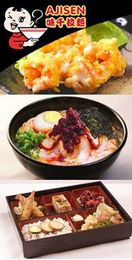
AJISEN (CHINA) Holdings Ltd (HK: 538) managed to do what few restaurant chains did in a tough economy – both boost profitability and expand.
Its first half 2009 turnover rose 24.3% year-on-year to 937 mln hkd, while profit from core operations jumped even faster, up 26.3% at 158 mln hkd.
As a result, the Japanese noodle eatery was able to fatten gross profit margins to a stellar 68.9% from 68.1%, very high in a notoriously tight sector.
The chain at last count was approaching 400 restaurants across China and Hong Kong, and had a foothold in 19 provinces.
The company’s CFO, Mr. Robert Lau, told NextInsight and Aries Consulting this week that the Ajisen was targeting 520 restaurants by the end of this year.
"If we expand by an average of just three new restaurants per year in each of our existing city presences, that means some 200 new sites for us. We’re targeting at least 120 new shops this year, 114 new ones in the PRC and six in Hong Kong. Our long term goal is over 1,000 shops by the end of 2014,” he said.
And expansion could be done on the relative cheap, without at all compromising the company’s longstanding commitment to quality and comfort.
For the first half last year, Ajisen (China) managed to reduce staff costs as a percentage of total revenue to 17.5% from 17.9% a year earlier, and new store investment costs were down by 10% per venue.
"Our first half profit from core ops was greatly helped by our cutting chief operating expenses to 13.5% of turnover from 14.5%. During the period, we controlled costs and boosted margins, and our performance was testimony to this commitment,” he added.

Photo: Andrew Vanburen
Soup base: Recipe for success
Ajisen (China) believed that at the end of the day, customer loyalty in the restaurant business was built primarily on the taste of a company’s offerings.That is why the Hong Kong-listed firm coveted its soup base recipe, and kept it a closely guarded secret.
"Rights to the soup base recipe from our parent firm constitute 3% of our total costs, but this is money well spent,” Mr. Lau said.
He added that total fixed costs for Ajisen (China) were relatively low, and allowed the company to keep such enviably high margins in a notoriously razor-thin margin sector – F&B.
"We pay our parent 3,500 yuan per month for each restaurant for licensing rights, and 7,000 hkd for the same privilege in Hong Kong. We also pay our parent a percentage of our packaged noodle sales revenue for technical assistance. In total, our fixed costs make up just 1% of our total revenue, and this affords us such high overall margins.”
The company enjoyed a perpetual license right to use the Ajisen brand in its PRC, Hong Kong and Macau restaurant.
Ajisen (China) also controlled costs by localizing production and suppliers.
We have a lot of on-site production in the PRC, including for noodles, soup mixes and meats. Our Japan parent has a production base in Shanghai which supplies our restaurants in China while the plant in Japan supplies our Hong Kong restaurants,” he said.
Also, local produce distributors supplied perishables like eggs at competitive prices and guaranteed freshness to restaurants which helped Ajisen (China) maintain such high profit margins.
Mr. Lau added that for the last reporting season – first half 2009 – revenue contribution from restaurants was 95% while that from sales of packaged ramen noodles to supermarkets and other restaurants made of 5%.
"We don’t expect this ratio to change much over the next five years, and if it does, the restaurant revenue contribution will likely increase.”
He added that Ajisen (China) had a strong preference for the group management model and only opted for the franchise option when absolutely necessary.
"Of our nearly 400 restaurants in China, only six are currently franchised out, and they are all located in airports. This is part of the requirement for renting space in their food courts.”
He said these six franchised venues handed over around 4% of their revenue to Ajisen (China) as royalty fees for the right to use the brand name.
"We prefer not to franchise as we like to ensure total control over quality and reputation.”
|
|||||||||||||||||
Next KFC?
US-based KFC is often pointed out as one of the biggest American success stories in the world’s most populous country.
The fast food eatery, a key part of the Yum Group of restaurants, has over 1,500 restaurants across China and is seemingly ubiquitous in major markets like Shanghai, Beijing, Guangzhou and Shenzhen.
"We currently have over 90 shops in Shanghai alone, so we are gradually catching up to KFC there. But we do better on a per customer basis, as average expenditure by each visitor to our restaurant is around 34 yuan, while at KFC it is 21 yuan,” Mr. Lau said.
But he said there was room for both chains to grow as the China pie was growing commensurately with the expanding economy.
"The economy in China continues its robust expansion and incomes are climbing along with it. There is room for growing acceptance among consumers for our relatively higher meal prices in the country, even in second tier cities.”



